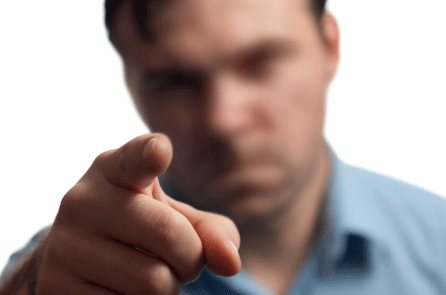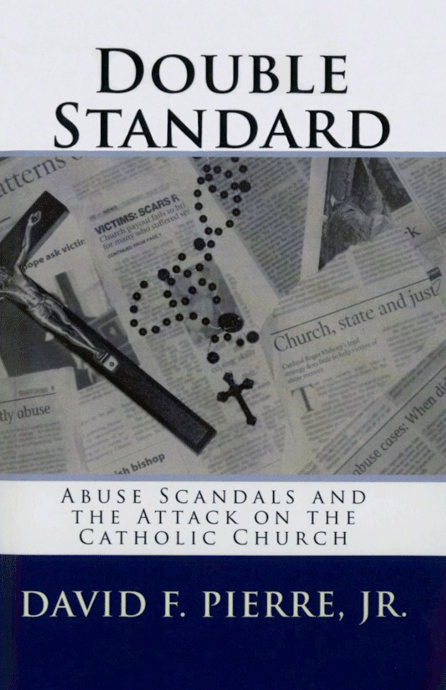When Priests are Falsely Accused Part 2: Why Accusers Should be Named
 In a sharp departure from similar claims against Catholic priests, the accusers of Baptist pastor, Bishop Eddie Long asked the news media to publish their names.This is Part 2 of a 3-part series. Please click here for Part 1 and Part 3.“Freedom Through Truth,” an excellent and insightful Canadian blog, has been profiling my situation as well as that of Father Mark Gruber who felt so deprived of basic civil and canonical rights that he filed suit against his bishop. In a post on September 10, 2010 entitled, “A Thorn in the Flesh,” Michael Brandon, who hosts “Freedom Through Truth,” wrote a profoundly troubling observation:
In a sharp departure from similar claims against Catholic priests, the accusers of Baptist pastor, Bishop Eddie Long asked the news media to publish their names.This is Part 2 of a 3-part series. Please click here for Part 1 and Part 3.“Freedom Through Truth,” an excellent and insightful Canadian blog, has been profiling my situation as well as that of Father Mark Gruber who felt so deprived of basic civil and canonical rights that he filed suit against his bishop. In a post on September 10, 2010 entitled, “A Thorn in the Flesh,” Michael Brandon, who hosts “Freedom Through Truth,” wrote a profoundly troubling observation:
“The Catholic Church has become the safest place in the world for children, but the most dangerous place in the world for our priests.”
I can’t imagine that sits well with any bishop, but in a post of my own last June, “Are Civil Liberties for Priests Intact?” I laid out what some have called a compelling case for how the Church’s sex abuse scandal has become like an ATM machine for lawyers and litigants at the expense of basic civil liberties for the priests accused.A few weeks ago (September 27), The Wall Street Journal ran a brief news story captioned, “Influential Pastor Pledges to Fight Sexual Allegations” by WSJ reporter Valerie Bauerlein. Among the Journal’s vast on-line global readership, it was the fifth most viewed article for that day. I wondered what made this particular Journal headline such a draw for on-line readers. I also wondered how many of those readers clicked on the article thinking, “Finally, one of them is fighting back.” I’ve been told by many readers of These Stone Walls that Catholics want unjustly accused priests and Church officials to fight false claims of abuse rather than just settle them. Did some Catholic priests refuse to sit quietly in exile while his Diocese threw money at yet another unnamed accuser with a newly discovered memory? But alas, the story was not about a Catholic priest at all.If you’ve read the two-part “A Priest’s Story” by Pulitzer Prize winning journalist Dorothy Rabinowitz, which was also published in the Wall Street Journal, you might have some of the same questions I have about the lurid accounts of sexual abuse alleged by several young men in recent law suits against Atlanta Baptist preacher, Bishop Eddie Long. I read with much sadness these claims against the “mega-church” pastor and TV evangelist. It certainly isn’t the case of “misery loves company!” No Catholic should take any comfort from the attention Bishop Eddie Long’s case is receiving in the news media.“RIPPED FROM THE HEADLINES?”On their face, however, the claims against the Baptist pastor are painfully familiar. The young men who accused him claimed that Bishop Long “groomed them,” “lavished them with gifts” to gain their trust, and then sexually abused them beginning when they were age 17 or 18.I make no judgment whatsoever on whether the claims are true, but these elements of the story are virtually carbon copies of hundreds of similar claims against Catholic priests. Some of the same formulaic terminology could have been lifted right out of the transcripts of my 1994 trial. That’s why the story of Bishop Eddie Long caught my attention.
I’ve been told by many readers of These Stone Walls that Catholics want unjustly accused priests and Church officials to fight false claims of abuse rather than just settle them. Did some Catholic priests refuse to sit quietly in exile while his Diocese threw money at yet another unnamed accuser with a newly discovered memory? But alas, the story was not about a Catholic priest at all.If you’ve read the two-part “A Priest’s Story” by Pulitzer Prize winning journalist Dorothy Rabinowitz, which was also published in the Wall Street Journal, you might have some of the same questions I have about the lurid accounts of sexual abuse alleged by several young men in recent law suits against Atlanta Baptist preacher, Bishop Eddie Long. I read with much sadness these claims against the “mega-church” pastor and TV evangelist. It certainly isn’t the case of “misery loves company!” No Catholic should take any comfort from the attention Bishop Eddie Long’s case is receiving in the news media.“RIPPED FROM THE HEADLINES?”On their face, however, the claims against the Baptist pastor are painfully familiar. The young men who accused him claimed that Bishop Long “groomed them,” “lavished them with gifts” to gain their trust, and then sexually abused them beginning when they were age 17 or 18.I make no judgment whatsoever on whether the claims are true, but these elements of the story are virtually carbon copies of hundreds of similar claims against Catholic priests. Some of the same formulaic terminology could have been lifted right out of the transcripts of my 1994 trial. That’s why the story of Bishop Eddie Long caught my attention.

There are other similarities between this case and typical sex abuse claims against priests. The news media – and Bishop Eddie Long’s accusers themselves through their contingency lawyers – spoke of the inherent abuse of power exhibited by the pastor if indeed the claims are true. But in apparent contradiction of that, the media also reported that criminal charges are highly unlikely in the case because the young men were above the age of legal consent – which is age 16 in Georgia as it is in New Hampshire and a number of other states. This implies that the Baptist bishop’s accusers on the one hand say they were victimized, while on the other hand the state itself says they consented to their own victimization. One wonders how they can be consenting victims.So like most claims against Catholic priests, there are lawsuits but no real investigation. But there is also something very different here. Actually, two things. First, all of Bishop Long’s accusers filed their lawsuits, at most, just two or three years after the alleged abuse. This is significant. The accuser at my trial alleged that his abuse ceased on the day before his 16th birthday. He claimed that he returned for counseling for his drug problem from week to week because he “repressed” the memory of being abused. He brought his charges, and a simultaneous lawsuit, eleven years after he claimed the abuse occurred.A full 70% of the claims for monetary damages alleging sexual abuse by Catholic priests were brought anywhere from one to five decades after the abuse was claimed to have occurred. Since 2002, organized groups like SNAP and VOTF – seemingly formed specifically to promote lawsuits against the Catholic Church – have also promoted legislation state by state to increase or discard statutes of limitation for bringing those lawsuits. These groups, and the contingency lawyers whose agenda they serve, have repeatedly declared that victims of sexual abuse cannot come to terms with it and report it for decades. Apparently, Baptist accusers need a lot less time than Catholic accusers.But there’s an even more striking difference between the Bishop Eddie Long case and similar claims against Catholic priests. The accusers of the Baptist preacher have assented to the publication of their names. From my perspective, that is a stunning distinction. The Associated Press reported on this fact in an article dated September 23, 2010 published in The Boston Globe:
“The Associated Press normally does not name people who say they are victims of sexual impropriety, but [plaintiff lawyer] Bernstein said that all three…have consented to making their identities public.”(Erin Haines and Greg Bluestein, “Abuse Charges Pain Many Members of Large Atlanta Church”)
Does that fact alone lend credence to the claims of accusers? I’m not sure of the answer to that, but I can’t help but wonder about it. Most claims against Catholic priests were brought anonymously as far as the public is concerned. As I pointed out in “Are Civil Liberties for Priests Intact?” one of the central issues that has trampled upon the right of many accused priests is their inability to confront their accusers in an open, public forum when their bishops settle claims and agree to anonymity for the accusers through typical non-disclosure clauses in mediated settlements from which the accused priests themselves are entirely excluded. Do you think for one moment that Bishop Eddie Long is barred from involvement in his church’s handling of the lawsuits against him and the church?FLEECING THE SHEPHERDSMany Catholic bishops have been accused of orchestrating a cover-up by the seemingly abhorrent practice of quietly transferring accused priests without reporting them to civil authorities or warning new parishes about the accusations. As indefensible as that revelation was, it represented only a fraction of the claims against the Catholic Church, and it hasn’t happened in the United States for over 20 years.I know that in my own Diocese of Manchester, New Hampshire, Church officials have followed a mandatory reporting law since it was enacted in 1979. Every accusation of sexual abuse of a minor by any priest in New Hampshire has been reported to civil authorities since that time. A supposed great scandal that erupted in 2002 was not that my bishop and diocese broke that law, but that they did not interpret it retroactively, and thus report to civil authorities in 1979 every allegation that preceded the enactment of the law – some going back as far as World War II.However one interprets the legal and ethical responsibilities of Church personnel, the fact remains that a full 70% of the claims against priests demanding monetary settlement were brought forward only in 2002 and after when a certain reality became crystal clear to potential plaintiffs and contingency lawyers.Noted Boston criminal defense and civil liberties lawyer, Harvey Silverglate, had something quite pointed to say about the onslaught of decades-old claims that have fractured and polarized the Church over the last eight years:
“There is considerable doubt about the veracity of many of the new claims, quite a few of which were made after it became apparent that the Church was willing to settle sex abuse cases for big bucks.” (“Fleecing the Shepherd,” Boston Phoenix, December 10-16, 2004).
I quoted the above in my 2005 article for Catalyst, “Sex Abuse and Signs of Fraud,” but I am not the only commentator who took note of Attorney Harvey Silverglate’s call for caution. David F. Pierre noted it too.
David F. Pierre, Jr. is the host of www.TheMediaReport.com, and author of what I think is a landmark book about the story of abuse in the Catholic Church. His meticulously researched new book is entitled Double Standard: Abuse Scandals and the Attack on the Catholic Church. It’s an important book, and we have added a link to it on the sidebar of These Stone Walls. If you have wondered how and why the Catholic Church and priesthood came – quite wrongly – to be equated with child sexual abuse in pop culture, David F. Pierre’s book is an important step toward understanding exactly what happened. It’s a courageous and compelling account of how money, media, and mayhem have distorted and driven the scandal and singled out the Catholic Church as a scapegoat for rampant abuse in our culture. No one can read David F. Pierre’s book and walk away believing justice has been served by the news media’s or SNAP’s treatment of the story.WHY I NAMED MY ACCUSERSI think – at least I hope – that most readers of These Stone Walls over the last year conclude that I have gone to great lengths to do the right thing. I hope you might also conclude that I would never place into public view the name of a real victim of sexual abuse without that person’s permission.But I will not hesitate to name any person whom I know has accused me or any other priest falsely and for profit, and have already done do with but one exception. The one exception is a person who accused me falsely in 2004 alleging abuse in 1981 or 1982, but I have postponed publication of this person’s name. As has been typical, nothing was filed in a court of law. His claim was simply placed with a lawyer who has choreographed the claims of scores of accusers for mass mediated settlements against many priests of my diocese.This lawyer’s settlements are described below. Only one fact has stayed my hand in publishing that accuser’s name for now. I know that the scant details the lawyer provided are entirely untrue of me, but one small detail might have been true of another priest who served in that same place, and at that same time, and who has also been accused by others. Even the possibility that this accuser may have been victimized by another priest has postponed, for now, publication of his name and claims.It is without a doubt that, in New Hampshire at least, government authorities entered into a prosecutorial witch hunt over decades old sexual abuse claims while giving fraud and larceny a free pass. Unfortunately, my own diocese has actually participated, through uncorroborated mediated settlements, in being a consenting victim of such fraud. In Double Standard, David F. Pierre noted something most disturbing in the way many claims against Catholic priests have been settled in New Hampshire without any legitimate determination of credibility:
“In 2002, a New Hampshire diocese faced accusations of abuse from 62 individuals. Rather than spending the time and resources looking into the merits of the cases, ‘Diocesan officials did not even ask for specifics such as the dates and specific allegations for the claims,’ New Hampshire’s Union Leader reported. Getting money from the diocese could Not have been any easier for the complainants. It was almost as Simple as a trip to an ATM machine… ‘I’ve never seen anything Like it,’ a pleased and much richer plaintiff attorney admitted.” (Double Standard, p. 125).
David F. Pierre was not the first person to notice this blatant disregard for the due process rights of accused priests by awarding financial settlements to accusers with no finding of facts whatsoever. On February 5, 2004, Catharine Henningsen, then editor of SALT: The Op Ed Page of the Catholic Church, delivered a speech to deaf ears at the Norwalk, Connecticut meeting of Voice of the Faithful:
“I am here today to argue that we cannot substitute the abuse of children with the abuse of accused priests. In the abuses I am about to outline for you, I believe you will agree that We have arrived at a point in our handling of these cases where Canon and civil law are being eroded to the detriment, and I think diminishment not only of who we are as human beings, but of who we Claim to be as Christians.”
The “abuse of accused priests” cited by Catharine Henningsen were the Diocese of Manchester settlements described above. She cited the same media reports cited by David F. Pierre in Double Standard. These settlements were also cited by me in a 2009 Catalyst article, “Due Process for Accused Priests.” How does a priest accused from ten, twenty, or thirty years ago defend himself or ever restore his name when a diocese simply writes a check with no other evidence of guilt than the claim itself? And unlike the lawsuits filed by the accusers of Bishop Eddie Long, the lawyer who was given a $5.2 million check by my diocese – the first of several rounds of mediated settlements with the same lawyer who proclaimed,
“I’ve never seen anything like it!” – didn’t even file the claims in a court of law. He simply wrote a letter demanding settlement, and got it.

Last month, the Concord Monitor reported on another case handled by that same lawyer with amazing result. But that case did not involve Catholic priests. The lawyer now represents one of several women who are suing a New Hampshire school district claiming they were repeatedly sexually abused by a teacher in the late 1970s when they were 15 yrs. old. And by the way, the Concord Monitor printed the names of the teacher’s accusers.JOHN DOE v. DIOCESE OF MANCHESTERI was stunned to read a New Hampshire judge’s decision last month that the school district cannot be sued because the civil statute of limitations for lawsuits has expired. The judge ruled that, at age 15, the accusers should have known their rights were being violated by the teacher, so the statute of limitations for a lawsuit began to toll when the women were 15 years old.In stark contrast, another New Hampshire judge ruled in that same court in 1996 that the lawsuits brought by my accusers against the Diocese of Manchester – accusers who were also 15 yrs. old at the time of their claims – could proceed with their lawsuits against my diocese. The statute of limitations in this judge’s ruling began to toll “only when the victims became aware they were injured” which can be 20 or 30 years later. Rather than appeal that lower court ruling, my diocese settled against my will, opening the door for the sort of unquestioned mediated settlements that are now bankrupting dioceses all over the country. However, when the accused is a teacher and school district, with accusers the same age as my accusers and from the same time period, the court ruled just the opposite.In his book, Contrary to Popular Opinion (Pharos Books, 1992) noted civil liberties lawyer and Harvard Law Professor Alan Dershowitz wrote no less than four essays defending why justice requires that accusers in sexual assault claims should be identified along with the accused. This is especially so when accusers bring civil lawsuits or other demands for compensation from a deeper pocket than that of the accused person himself. When accusers have a monetary motive, and the courts issue conflicting rulings allowing them to proceed decades later – but exclusively against Catholic priests – then the names of accusers should be scrutinized as well. My accuser at trial walked away with $200,000 for the lie that took away my freedom.JUST HOW GULLIBLE ARE WE?As I was writing this post, a few younger prisoners stopped to talk with me. They are the same age as Bishop Eddie Long’s accusers, so I asked their opinion on the case. They were careful to weigh both sides. But when I told them about the rest of this post, they all started laughing, and I asked them why.
“People are so gullible,” one said. “People think no one would accuse a priest just for money. I know a lot of people who would do it in a heartbeat.” He added, ironically, “About the only person we wouldn’t do this to is you!”
Are people really as gullible as this young prisoner suspects? Do Catholics really believe every sordid story of priests’ exploiting helpless and hapless teenagers all those years ago? Just before I wrote “Sex Abuse and Signs of Fraud” for The Catholic League in 2005, I was approached by a prisoner with an offer he thought I couldn’t refuse.
He asked me if I could find out the name of a priest – any priest – who might have been present in his childhood community around 1972 or so. He said he heard the Church would settle if he accused a priest of sexually abusing him back then. He offered to give me some of the money. Of course, I refused. I thought he was joking. I was wrong.
Two years later, I read in a local newspaper that the same lawyer described above – “I’ve never seen anything like it!” – was representing a prison inmate “whose life was ruined” when he was sexually abused by a now 80 year old priest in that same community in 1972. It was, of course, the same guy who approached me. I quickly wrote to a lawyer for my diocese informing him that I had firsthand knowledge of this scam. I urged him and the diocese not to settle this claim, but to expose and publish the name of this accuser because I had information that would clear the accused priest and expose this fraud.I never received any reply. My own gullibility, at least, is long gone.
![]()

